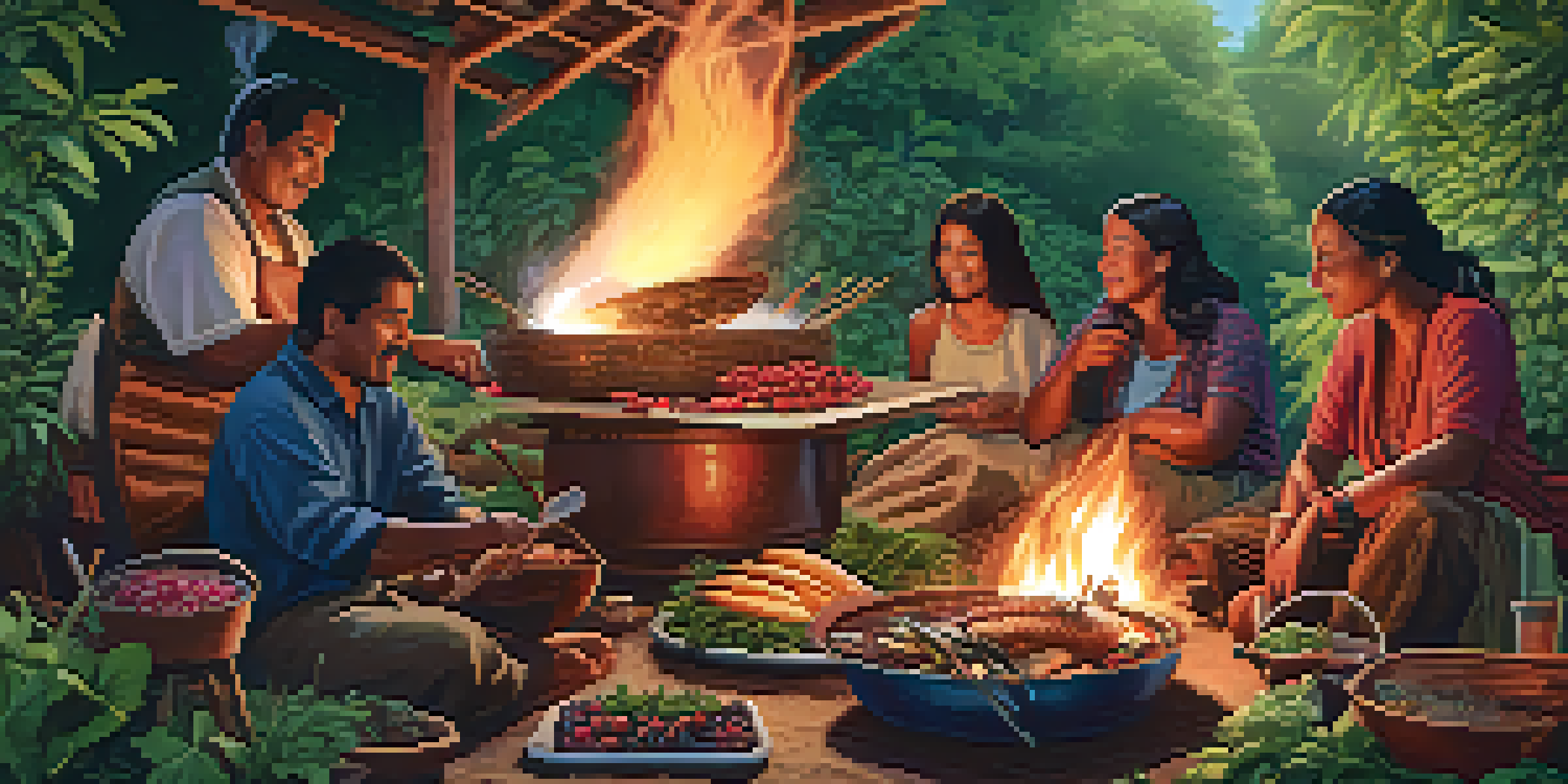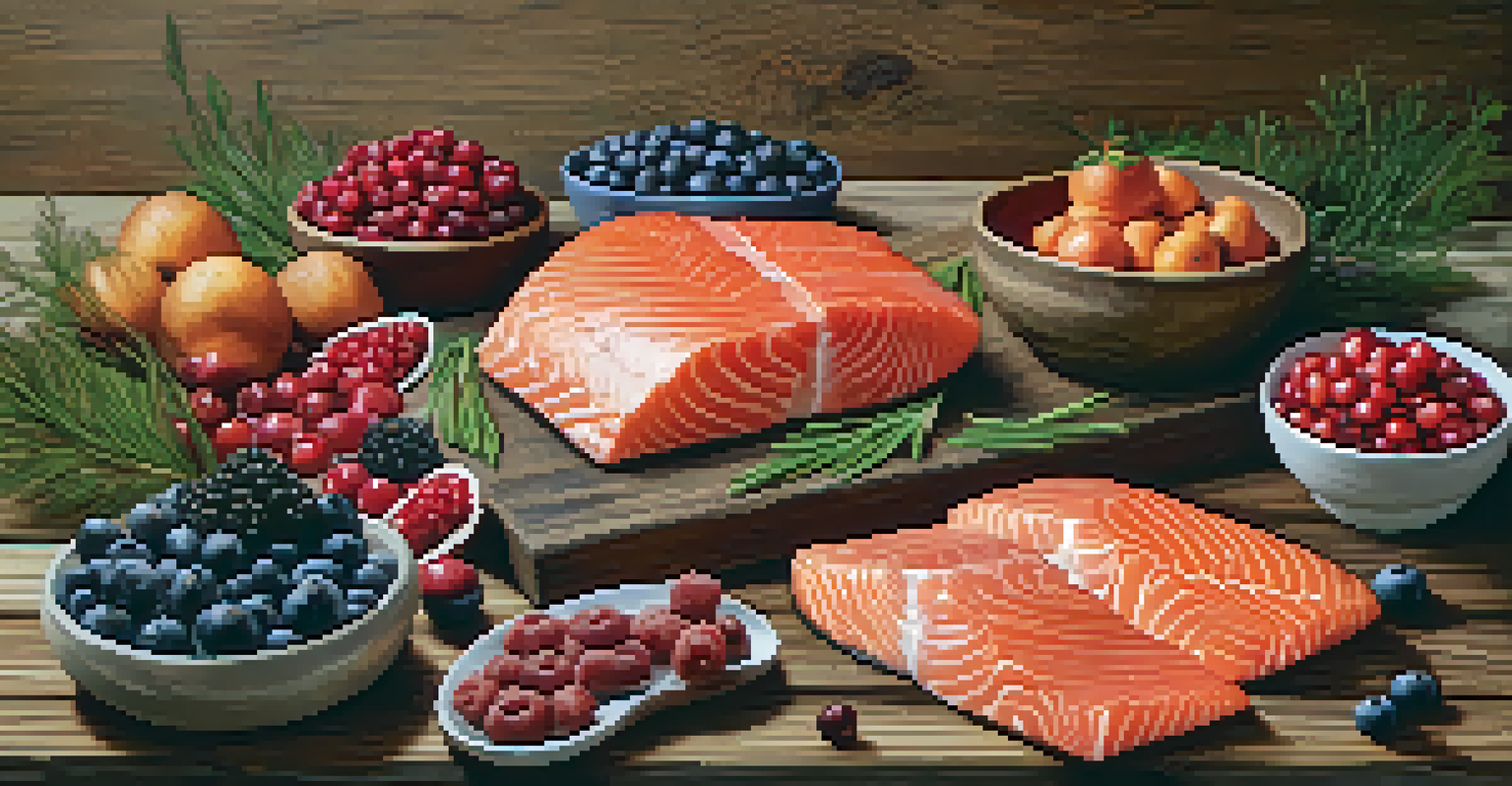Culinary Heritage: Discovering Indigenous Foods in Canada

Understanding Indigenous Culinary Heritage in Canada
Indigenous culinary heritage in Canada is a vibrant tapestry woven from the diverse cultures of First Nations, Inuit, and Métis peoples. These communities have developed unique food systems based on their deep connection to the land and its resources. Understanding this heritage is essential, as it reveals not only traditional recipes but also the spiritual and cultural significance behind them.
Food is a central part of our lives and an important component of our identity. It connects us to our ancestors, our culture, and our land.
At the heart of Indigenous cooking lies the principle of sustainability. Traditional practices emphasize using local ingredients, which promotes biodiversity and conservation. This approach contrasts sharply with modern industrial food systems, making Indigenous cuisine a beacon of ecological awareness and respect for nature.
By exploring Indigenous culinary heritage, we can appreciate the stories and traditions that shape these foods. Each dish tells a story of resilience, adaptation, and survival, showcasing the importance of food as a cultural pillar in Indigenous communities.
Key Ingredients in Indigenous Canadian Cuisine
Indigenous foods often feature a variety of ingredients that are native to Canada, such as wild game, fish, berries, and medicinal plants. For instance, bison and venison provide rich sources of protein, while fish like salmon and trout are staples in coastal communities. These ingredients are not only delicious but also packed with nutrients, reflecting a diet that is both healthy and sustainable.

Berries, such as blueberries, cranberries, and Saskatoon berries, play a significant role in Indigenous diets. They are often used in jams, desserts, and traditional dishes, showcasing the versatility of seasonal harvests. The process of foraging for these berries connects communities to their ancestral lands, reinforcing cultural identity and knowledge.
Indigenous Foods Reflect Cultural Heritage
Indigenous culinary heritage showcases unique food systems rooted in the cultural and spiritual connections to the land.
Moreover, medicinal plants, like sweetgrass and sage, are integral to culinary practices. They add flavor while also serving ceremonial purposes, highlighting the holistic approach Indigenous peoples take towards food. This connection between food and health illustrates the deep cultural significance embedded in every ingredient.
Traditional Cooking Techniques of Indigenous Peoples
Indigenous cooking techniques draw from centuries of knowledge and innovation. Methods such as smoking, drying, and fermenting are commonly used to preserve food and enhance flavors. For instance, smoked fish is a delicacy that not only provides a unique taste but also extends the shelf life of the catch.
Indigenous food sovereignty is about reconnecting with our traditional food systems and the lands that sustain us.
Cooking over an open flame is another traditional technique, often used during community gatherings and celebrations. This method fosters a sense of togetherness, as families and friends come together to share meals. The act of cooking outdoors also connects people to nature, emphasizing the importance of the environment in Indigenous culinary practices.
Additionally, the use of earth ovens—traditional pits dug into the ground—illustrates the resourcefulness of Indigenous peoples. Food is wrapped in leaves and buried with hot stones, allowing for slow cooking that infuses flavors. This technique not only honors ancestral traditions but also showcases the innovative spirit of Indigenous foodways.
The Role of Seasonal Foods in Indigenous Diets
Seasonality is a cornerstone of Indigenous diets, with each season bringing its own bounty. For example, spring is often celebrated with the arrival of fresh greens and fish, while summer is the time for berry picking and gardening. This seasonal rhythm reinforces the connection between Indigenous peoples and their environment, promoting a sustainable approach to sourcing food.
The practice of harvesting ingredients at their peak not only enhances flavor but also ensures that communities thrive in harmony with nature. By following the natural cycles of growth and decay, Indigenous peoples have developed a profound understanding of their local ecosystems. This knowledge is passed down through generations, ensuring that traditional practices remain alive.
Importance of Food Sovereignty
Food sovereignty empowers Indigenous communities to reclaim their traditional food systems, promoting self-sufficiency and cultural identity.
Moreover, seasonal foods are often celebrated through festivals and gatherings, reinforcing community bonds. These events allow families to come together, share stories, and honor their heritage, creating lasting memories tied to the land and its resources.
Exploring Modern Interpretations of Indigenous Foods
In recent years, there has been a resurgence of interest in Indigenous foods, both in traditional forms and modern interpretations. Chefs are creatively incorporating Indigenous ingredients into contemporary dishes, bridging the gap between past and present. This fusion not only showcases the versatility of Indigenous foods but also raises awareness about their cultural significance.
Restaurants that focus on Indigenous cuisine are popping up across Canada, celebrating authentic flavors while also providing a platform for Indigenous chefs. These culinary pioneers often draw on their heritage to create innovative dishes that respect traditional practices while appealing to modern palates. It's a delicious way to educate diners about Indigenous cultures.
This movement also emphasizes the importance of supporting Indigenous food sovereignty, encouraging communities to reclaim their food systems. By highlighting Indigenous ingredients in mainstream culinary settings, chefs are helping to shift perceptions and foster a deeper appreciation for this rich culinary heritage.
Indigenous Food Sovereignty and Its Importance
Food sovereignty refers to the right of communities to control their own food systems, a concept rooted in Indigenous traditions. This movement aims to empower Indigenous peoples to reclaim their agricultural practices, protect their food sources, and promote self-sufficiency. It emphasizes the importance of local foods and sustainable practices, aligning with the values of Indigenous culinary heritage.
Historically, colonialism disrupted Indigenous food systems, leading to reliance on industrial agriculture and processed foods. The fight for food sovereignty seeks to rectify these injustices by promoting traditional knowledge and practices. By prioritizing Indigenous foods, communities can strengthen their cultural identity and resilience.
Seasonality in Indigenous Diets
The seasonal rhythm of harvesting ingredients underscores the deep relationship between Indigenous peoples and their environment.
Moreover, food sovereignty has far-reaching implications for health and well-being. Access to traditional foods can combat diet-related diseases that disproportionately affect Indigenous populations. By reconnecting with their culinary heritage, communities can foster healthier lifestyles and reclaim agency over their food choices.
Celebrating Indigenous Culinary Heritage Through Education
Education plays a vital role in preserving and celebrating Indigenous culinary heritage. Schools and community programs are increasingly incorporating traditional cooking classes, allowing younger generations to learn about their cultural roots. These hands-on experiences create a lasting impact, fostering pride and appreciation for Indigenous foods.
Additionally, workshops and events featuring Indigenous chefs provide opportunities for knowledge sharing and cultural exchange. These gatherings encourage dialogue about food systems, sustainability, and the importance of Indigenous culinary practices. By inviting non-Indigenous individuals to participate, these events promote understanding and respect for diverse food traditions.

Through education, we can cultivate a deeper connection to Indigenous foods and the stories they carry. As communities come together to learn and share, they help to ensure that culinary heritage is not only preserved but also celebrated for generations to come.